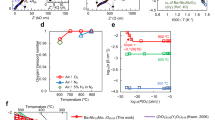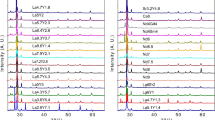Abstract
Lowering the operating temperature of solid oxide fuel cells (SOFCs) has extensively stimulated the development of new oxide ion conductors. Here, inspired by the structural commonalities of oxide ion conductors, the inability to accommodate oxygen vacancies in the rigid, isolated, 3-fold tetrahedral rings of SrSi/GeO3-based materials, and the considerable flexibility of BOn polyhedra in terms of coordination number, rotation, deformation, and linkage, we report the first borate-base family of oxide ion conductors, (Gd/Y)1−xZnxBO3−0.5x, through combined computational prediction and experimental verification. The oxygen vacancies in (Gd/Y)BO3 can be accommodated by forming B3O8 units in isolated, 3-fold, tetrahedral rings of B3O9 and transported through a cooperative mechanism of oxygen exchange between the B3O9 and B3O8 units, which is assisted by the intermediate opening and extending of these units. This study opens a new scientific field of the borate system for designing and discovering oxide ion conductors.

摘要
降低固体氧化物燃料电池(SOFCs)的工作温度正在推动新型氧离子导体材料的开发. 在此, 受氧离子导体材料结构共性的启发, 基于Sr(Si/Ge)O3材料中刚性(Si/Ge)3O9基团无法容纳氧空位, 以及BOn 多面体在配位数、旋转、变形和连接上的巨大灵活性, 我们首次通过计算预测和实验验证, 报道了基于硼酸盐的新型氧离子导体材料(Gd/Y)1−x-ZnxBO3−0.5x. (Gd/Y)BO3 中的氧空位可以通过孤立的B3O9 三元环形成B3O8 结构单元来容纳, 并通过B3O9 和B3O8 单元之间的氧交换合作机制来传输, 而这些结构单元作为过渡态的打开和伸展则有助于氧的传输.这项研究为设计和开发新型氧离子导体开辟了新方向, 有望从硼酸盐家族发现更多新的氧离子导体.
Similar content being viewed by others
Change history
01 November 2022
An Erratum to this paper has been published: https://doi.org/10.1007/s40843-022-2284-9
References
Park S, Vohs JM, Gorte RJ. Direct oxidation of hydrocarbons in a solid-oxide fuel cell. Nature, 2000, 404: 265–267
Famprikis T, Canepa P, Dawson JA, et al. Fundamentals of inorganic solid-state electrolytes for batteries. Nat Mater, 2019, 18: 1278–1291
Li X, Kuang X, Sun J. Rare earth elements based oxide ion conductors. Inorg Chem Front, 2021, 8: 1374–1398
Wachsman ED, Lee KT. Lowering the temperature of solid oxide fuel cells. Science, 2011, 334: 935–939
Kharton V, Marques F, Atkinson A. Transport properties of solid oxide electrolyte ceramics: A brief review. Solid State Ion, 2004, 174: 135–149
Kudo T, Obayashi H. Oxygen ion conduction of the fluorite-type Ce1−xLnxO2−x/2 (Ln = lanthanoid element). J Electrochem Soc, 1975, 122: 142–147
Inaba H, Tagawa H. Ceria-based solid electrolytes. Solid State Ion, 1996, 83: 1–16
Ishihara T, Furutani H, Honda M, et al. Improved oxide ion conductivity in La0.8Sr0.2Ga0.8Mg0.2O3 by doping Co. Chem Mater, 1999, 11: 2081–2088
Li M, Pietrowski MJ, De Souza RA, et al. A family of oxide ion conductors based on the ferroelectric perovskite Na0.5Bi0.5TiO3. Nat Mater, 2014, 13: 31–35
Frayret C, Villesuzanne A, Pouchard M. Application of density functional theory to the modeling of the mixed ionic and electronic conductor La2NiO4+δ: Lattice relaxation, oxygen mobility, and energetics of Frenkel defects. Chem Mater, 2005, 17: 6538–6544
Kim JH, Lee KT, Kim YN, et al. Crystal chemistry and electrochemical properties of Ln(Sr,Ca)3(Fe,Co)3O10 intergrowth oxide cathodes for solid oxide fuel cells. J Mater Chem, 2011, 21: 2482–2488
Amow G, Davidson I, Skinner S. A comparative study of the Ruddlesden-Popper series, Lan+1NinO3n+1 (n = 1, 2 and 3), for solid-oxide fuel-cell cathode applications. Solid State Ion, 2006, 177: 1205–1210
Kim JH, Manthiram A. Layered LnBaCo2O5+δ perovskite cathodes for solid oxide fuel cells: An overview and perspective. J Mater Chem A, 2015, 3: 24195–24210
Yaguchi H, Fujii K, Yashima M. A new structure family of oxide-ion conductors based on BaGdInO4. J Mater Chem A, 2020, 8: 8638–8647
Yashima M, Tsujiguchi T, Sakuda Y, et al. High oxide-ion conductivity through the interstitial oxygen site in Ba7Nb4MoO20-based hexagonal perovskite related oxides. Nat Commun, 2021, 12: 556
Chambers MS, McCombie KS, Auckett JE, et al. Hexagonal perovskite related oxide ion conductor Ba3NbMoO8.5: Phase transition, temperature evolution of the local structure and properties. J Mater Chem A, 2019, 7: 25503–25510
Kuang X, Green MA, Niu H, et al. Interstitial oxide ion conductivity in the layered tetrahedral network melilite structure. Nat Mater, 2008, 7: 498–504
Tolchard J, Slater P, Islam M. Insight into doping effects in apatite silicate ionic conductors. Adv Funct Mater, 2007, 17: 2564–2571
Tate ML, Blom DA, Avdeev M, et al. New apatite-type oxide ion conductor, Bi2La8[(GeO4)6]O3: Structure, properties, and direct imaging of low-level interstitial oxygen atoms using aberration-corrected scanning transmission electron microscopy. Adv Funct Mater, 2017, 27: 1605625
León-Reina L, Losilla ER, Martínez-Lara M, et al. High oxide ion conductivity in Al-doped germanium oxyapatite. Chem Mater, 2005, 17: 596–600
Yang X, Fernandez-Carrion AJ, Wang J, et al. Cooperative mechanisms of oxygen vacancy stabilization and migration in the isolated tetrahedral anion scheelite structure. Nat Commun, 2018, 9: 4484
Li J, Pan F, Geng S, et al. Modulated structure determination and ion transport mechanism of oxide-ion conductor CeNbO4+δ. Nat Commun, 2020, 11: 4751
Esaka T, Minaai T, Iwahara H. Oxide ion conduction in the solid solution based on the scheelite-type oxide PbWO4. Solid State Ion, 1992, 57: 319–325
Evans IR, Howard JAK, Evans JSO. The crystal structure of α-La2Mo2O9 and the structural origin of the oxide ion migration pathway. Chem Mater, 2005, 17: 4074–4077
Jalarvo N, Gourdon O, Bi Z, et al. Atomic-scale picture of the ion conduction mechanism in a tetrahedral network of lanthanum barium gallate. Chem Mater, 2013, 25: 2741–2748
Huang C, Mutailipu M, Zhang F, et al. Expanding the chemistry of borates with functional [BO2]− anions. Nat Commun, 2021, 12: 2597
Mutailipu M, Poeppelmeier KR, Pan S. Borates: A rich source for optical materials. Chem Rev, 2021, 121: 1130–1202
Becker P. Borate materials in nonlinear optics. Adv Mater, 1998, 10: 979–992
Huppertz H, von der Eltz B. Multianvil high-pressure synthesis of Dy4B6O15: The first oxoborate with edge-sharing BO4 tetrahedra. J Am Chem Soc, 2002, 124: 9376–9377
Sun X, Yang R, Song R, et al. β-RE1−xBixB3O6 (RE = Sm, Eu, Gd, Tb, Dy, Ho, Er, Y): Bi3+ substitution induced formation of metastable rare earth borates at ambient pressure. Inorg Chem, 2016, 55: 9276–9283
Clark JR, Appleman DE. Pentaborate polyanion in the crystal structure of ulexite, NaCaB5O6(OH)6·5H2O. Science, 1964, 145: 1295–1296
Zhang HX, Zhang J, Zheng ST, et al. K2[Ge(B4O9)]·2H2O: A unique 3D alternating linkage mode of a B4O9 cluster and GeO4 unit in borogermanate with two pairs of interweaving double helical channels. Inorg Chem, 2004, 43: 6148–6150
Menchetti S, Sabelli C, Trosti-Ferroni R. The structure of sodium borate Na3[B5O9]·H2O. Acta Crystlogr B Struct Crystlogr Cryst Chem, 1982, 38: 2987–2991
Singh P, Goodenough JB. Sr1−xKxSi1−yGey,O3−0.5x: A new family of superior oxide-ion conductors. Energy Environ Sci, 2012, 5: 9626–9631
Singh P, Goodenough JB. Monoclinic Sr1−xNaxSiO3−0.5x: New superior oxide ion electrolytes. J Am Chem Soc, 2013, 135: 10149–10154
Evans IR, Evans JSO, Davies HG, et al. On Sr1−xNaxSiO3−0.5x new superior fast ion conductors. Chem Mater, 2014, 26: 5187–5189
Inglis KK, Corley JP, Florian P, et al. Structure and sodium ion dynamics in sodium strontium silicate investigated by multinuclear solidstate NMR. Chem Mater, 2016, 28: 3850–3861
Bayliss RD, Cook SN, Scanlon DO, et al. Understanding the defect chemistry of alkali metal strontium silicate solid solutions: Insights from experiment and theory. J Mater Chem A, 2014, 2: 17919–17924
Wells A. Structural Inorganic Chemistry. Cambridge, Mass: Oxford University Press, 1984. 1045–1081
Ren M, Lin JH, Dong Y, et al. Structure and phase transition of GdBO3. Chem Mater, 1999, 11: 1576–1580
Pitscheider A, Kaindl R, Oeckler O, et al. The crystal structure of π-ErBO3: New single-crystal data for an old problem. J Solid State Chem, 2011, 184: 149–153
Chapon LC, Manuel P, Radaelli PG, et al. Wish: The new powder and single crystal magnetic diffractometer on the second target station. Neutron News, 2011, 22: 22–25
Kaur A, Khanna A, Bhatt H, et al. B-O and Te-O speciation in bismuth tellurite and bismuth borotellurite glasses by FTIR,11B MAS-NMR and Raman spectroscopy. J Non-Crystalline Solids, 2017, 470: 19–26
Tsai DS, Hsieh MJ, Tseng JC, et al. Ionic conductivities and phase transitions of lanthanide rare-earth substituted La2Mo2O9. J Eur Ceramic Soc, 2005, 25: 481–487
Badwal S. Scandia-zirconia electrolytes for intermediate temperature solid oxide fuel cell operation. Solid State Ion, 2000, 136–137: 91–99
Dušek M, Petříček V, Palatinus L, et al. Jana2006 Cookbook. Czech Republic: Institute of Physics ASCR, v.v.i., Na Slovance 2, Prague, 2019
Brown ID, Altermatt D. Bond-valence parameters obtained from a systematic analysis of the inorganic crystal structure database. Acta Crystlogr B Struct Sci, 1985, 41: 244–247
Jing XR, West A. AC impedance and gas concentration cell measurements for Ba12Y4.67Ti8O35. Acta Physico-Chim Sin, 2002, 18: 617–623
Hohenberg P, Kohn W. Inhomogeneous electron gas. Phys Rev, 1964, 136: B864–B871
Blöchl PE. Projector augmented-wave method. Phys Rev B, 1994, 50: 17953–17979
Kresse G, Furthmüller J. Efficient iterative schemes for ab initio total-energy calculations using a plane-wave basis set. Phys Rev B, 1996, 54: 11169–11186
Perdew JP, Burke K, Ernzerhof M. Generalized gradient approximation made simple. Phys Rev Lett, 1996, 77: 3865–3868
Nosé S. A unified formulation of the constant temperature molecular dynamics methods. J Chem Phys, 1984, 81: 511–519
Humphrey W, Dalke A, Schulten K. VMD: Visual molecular dynamics. J Mol Graphics, 1996, 14: 33–38
Acknowledgements
Kuang X thanks the National Natural Science Foundation of China (22090043 and 21622101) and Guangxi Natural Science Foundation (2019GXNSFGA245006) for financial support. Sun J thanks the National Natural Science Foundation of China (21527803 and 21621061) and the Ministry of Science and Technology of China (2016YFA0301004) for financial support. Li X acknowledges the funding from China Postdoctoral Science Foundation (8206300392). We thank STFC/ISIS for access to beamline WISH.
Author information
Authors and Affiliations
Contributions
Li X carried out the syntheses and characterization of samples, as well as data analysis, and prepared the manuscript. Yang L performed the molecular dynamics simulations and oxygen vacancy formation energy calculations. Zhu Z performed the EMF measurements and provided the solid-state spectrum of the reference H3BO3. Wang X and Chen B performed the RED data collection. Huang S collected the energy spectra and TEM mapping data. Wei X and Cai G collected the variable temperature XRD data. Manuel P and Yang S helped collect the neutron diffraction data. Kuang X and Sun J conceived and supervised the project and revised the manuscript. All authors commented on the manuscript.
Corresponding authors
Additional information
Conflict of interest
The authors declare that they have no conflict of interest.
Supplementary information
Supporting data are available in the online version of the paper.
Xiaohui Li recieved his PhD degree from Sun Yat-Sen University in 2019. After finishing his postdoctoral work in Junliang Sun’s group at Peking University in 2021, he joined the Institute of Solid State Chemistry led by Xianran Xing at the University of Science and Technology Beijing. His research interests include the development of new oxide ion conductors, inorganic luminescence materials, and nitride dielectric materials.
Xiaojun Kuang received his BSc degree in chemistry from Nanchang University in 1999 and PhD degree in inorganic chemistry from Peking University in 2004. After post-doctoral trainning at the University of Liverpool and University of Durham, he was appointed as an associate professor at the School of Chemistry, Sun Yat-Sen University in 2010 before he settled down in Guilin in 2013. His current research interests include the discovery of new oxide ion conductors, oxide and (oxy)nitride dielectrics and their structure-property relationship.
Junliang Sun is a full professor at Peking University and the recipient of the National Science Foundation Distinguished Young Scholars Program. He received his BSc degree (2001) and PhD degree (2006) in chemistry from Peking University. After finishing his postdoctoral work at Cornell University and Stockholm University, he became an assistant professor at Stockholm University in 2009. In 2012, he moved to Peking University. His current research interests include the method development for structure determination, and synthesis and applications of porous materials and dense oxides.
Rights and permissions
About this article
Cite this article
Li, X., Yang, L., Zhu, Z. et al. Borates as a new direction in the design of oxide ion conductors. Sci. China Mater. 65, 2737–2745 (2022). https://doi.org/10.1007/s40843-022-2044-3
Received:
Accepted:
Published:
Issue Date:
DOI: https://doi.org/10.1007/s40843-022-2044-3




